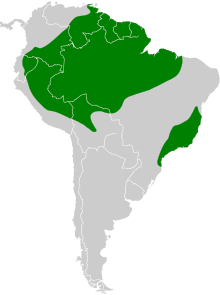Black-eared fairy
| Black-eared fairy | |
|---|---|

| |
| Scientific classification | |
| Domain: | Eukaryota |
| Kingdom: | Animalia |
| Phylum: | Chordata |
| Class: | Aves |
| Clade: | Strisores |
| Order: | Apodiformes |
| Family: | Trochilidae |
| Genus: | Heliothryx |
| Species: | H. auritus
|
| Binomial name | |
| Heliothryx auritus (Gmelin, JF, 1788)
| |

| |
The black-eared fairy (Heliothryx auritus) is a species of hummingbird in the subfamily Polytminae, the mangoes. It is found in every mainland South American country except Argentina, Chile, Paraguay, and Uruguay.
Taxonomy
The black-eared fairy was
Three subspecies are recognised:[7]
- H. a. auritus (Gmelin, JF, 1788) – southeast Colombia and east Ecuador through Venezuela, the Guianas and north Brazil
- H. a. phainolaemus Gould, 1855 – north-central Brazil (south of the Amazon)
- H. a. auriculatus (Nordmann, 1835) – east Peru to central Bolivia and central, east Brazil
The black-eared fairy and the

Description
The black-eared fairy is 10.1 to 13.7 cm (4.0 to 5.4 in) long and weighs 4 to 6.3 g (0.14 to 0.22 oz). The nominate male has bright shiny green upperparts, pure white underparts, and a long pointed tail which has darkish blue central and white outer feathers. It has a black patch below the eye, glittering purple ear coverts, and a short, straight, black bill. The female is similar but has no purple on the face, its throat and breast have grayish dots, and the three outer pairs of tail feathers have a black band at their base. Immatures have cinnamon fringes on their upperparts' plumage and are otherwise similar to the female. The male H. a. auriculatus has green on the chin and the sides of its throat. The male H. a. phainolaemus has a variable green throat and chin and the female does not have the nominate's gray spots on the underparts.[11]
The calls include "a short high-pitched 'tsit' and richer 'tchip', repeated at intervals."[11]
Distribution and habitat
The nominate subspecies of black-eared fairy is found from southeastern
The black-eared fairy is believed to be sedentary, but some irregular movements have been reported in southern Brazil.[11]
Behavior
Food and feeding
The black-eared fairy mostly forages in the mid-story and canopy, though in
Breeding
The black-eared fairy breeds throughout the year. The female alone builds the nest, incubates the eggs, and cares for the young. It makes a small cup nest of plant down on a vertical branch, usually between 3 and 30 m (9.8 and 98 ft) above the ground. The clutch size is two eggs. The incubation time is 15 to 16 days with fledging 23 to 26 days after hatch. It breeds for the first time when in its second year.[11]
Status
The International Union for Conservation of Nature has assessed the black-eared fairy as being of Least Concern, though its population size is not known and believed to be decreasing.[1] It has a very large range, is considered fairly common in parts of it, and occurs in several protected areas.[11]
References
- ^ . Retrieved 15 December 2021.
- ^ "Appendices | CITES". cites.org. Retrieved 2022-01-14.
- ^ Gmelin, Johann Friedrich (1788). Systema naturae per regna tria naturae : secundum classes, ordines, genera, species, cum characteribus, differentiis, synonymis, locis (in Latin). Vol. 1, Part 1 (13th ed.). Lipsiae [Leipzig]: Georg. Emanuel. Beer. p. 493.
- ^ Brisson, Mathurin Jacques (1760). Ornithologie, ou, Méthode Contenant la Division des Oiseaux en Ordres, Sections, Genres, Especes & leurs Variétés (in French and Latin). Vol. 3. Paris: Jean-Baptiste Bauche. pp. 722–723, Plate 27, fig 2. The two stars (**) at the start of the section indicates that Brisson based his description on the examination of a specimen.
- ^ Buffon, Georges-Louis Leclerc de (1779). "L'oiseau-mouche à oreilles". Histoire Naturelle des Oiseaux (in French). Vol. 6. Paris: De l'Imprimerie Royale. pp. 32–33.
- ^ Boie, Friedrich (1831). "Bemerkungen über Species und einige ornithologische Familien und Sippen". Isis von Oken (in German). Cols 538–548 [547].
- ^ Rasmussen, Pamela, eds. (January 2022). "Hummingbirds". IOC World Bird List Version 12.1. International Ornithologists' Union. Retrieved 11 July 2022.
- ISBN 978-1-4081-2501-4.
- ^ Peters, James Lee, ed. (1945). Check-List of Birds of the World. Vol. 5. Cambridge, Massachusetts: Harvard University Press. p. 127.
- ^ Remsen, J. V., Jr., J. I. Areta, E. Bonaccorso, S. Claramunt, A. Jaramillo, D. F. Lane, J. F. Pacheco, M. B. Robbins, F. G. Stiles, and K. J. Zimmer. Version 24 August 2021. A classification of the bird species of South America. American Ornithological Society. https://www.museum.lsu.edu/~Remsen/SACCBaseline.htm retrieved August 24, 2021
- ^ a b c d e f g Schuchmann, K.L., G. M. Kirwan, and P. F. D. Boesman (2020). Black-eared Fairy (Heliothryx auritus), version 1.0. In Birds of the World (J. del Hoyo, A. Elliott, J. Sargatal, D. A. Christie, and E. de Juana, Editors). Cornell Lab of Ornithology, Ithaca, NY, USA. https://doi.org/10.2173/bow.bkefai1.01 retrieved December 15, 2021

